Asus P5GC-VM User Manual

P5GC-VM
Motherboard

E3222
First Edition
July 2007
Copyright © 2007 ASUSTeK COMPUTER INC. All Rights Reserved.
No part of this manual, including the products and software described in it, may be reproduced, transmitted, transcribed, stored in a retrieval system, or translated into any language in any form or by any means, except documentation kept by the purchaser for backup purposes, without the express written permission of ASUSTeK COMPUTER INC. (“ASUS”).
Product warranty or service will not be extended if: (1) the product is repaired, modified or altered, unless such repair, modification of alteration is authorized in writing byASUS; or (2) the serial number of the product is defaced or missing.
ASUS PROVIDES THIS MANUAL “AS IS” WITHOUT WARRANTY OF ANY KIND, EITHER EXPRESS OR IMPLIED, INCLUDING BUT NOT LIMITED TO THE IMPLIED WARRANTIES OR CONDITIONS OF MERCHANTABILITY OR FITNESS FOR A PARTICULAR PURPOSE. IN NO EVENT SHALL ASUS, ITS DIRECTORS, OFFICERS, EMPLOYEES OR AGENTS BE LIABLE FOR ANY INDIRECT, SPECIAL, INCIDENTAL, OR CONSEQUENTIAL DAMAGES (INCLUDING DAMAGES FOR LOSS OF PROFITS, LOSS OF BUSINESS, LOSS OF USE OR DATA, INTERRUPTION OF BUSINESS AND THE LIKE), EVEN IF ASUS HAS BEEN ADVISED OF THE POSSIBILITY OF SUCH DAMAGES ARISING FROM ANY DEFECT OR ERROR IN THIS MANUAL OR PRODUCT.
SPECIFICATIONS AND INFORMATION CONTAINED IN THIS MANUAL ARE FURNISHED FOR INFORMATIONAL USE ONLY, AND ARE SUBJECT TO CHANGE AT ANY TIME WITHOUT NOTICE, AND SHOULD NOT BE CONSTRUED AS A COMMITMENT BY ASUS. ASUS ASSUMES NO RESPONSIBILITY OR LIABILITY FOR ANY ERRORS OR INACCURACIES THAT MAY APPEAR IN THIS MANUAL, INCLUDING THE PRODUCTS AND SOFTWARE DESCRIBED IN IT.
Products and corporate names appearing in this manual may or may not be registered trademarks or copyrights of their respective companies, and are used only for identification or explanation and to the owners’ benefit, without intent to infringe.
ii

Contents
Notices......................................................................................................... |
vi |
Safety information...................................................................................... |
vii |
About this guide........................................................................................ |
viii |
P5GC-VM specifications summary............................................................. |
x |
Chapter 1: Product introduction
1.1 |
Welcome!....................................................................................... |
1-2 |
|
1.2 |
Package contents......................................................................... |
1-2 |
|
1.3 |
Special features............................................................................ |
1-2 |
|
|
1.3.1 |
Product highlights............................................................ |
1-2 |
|
1.3.2 |
InnovativeASUS features................................................ |
1-5 |
1.4 |
Before you proceed...................................................................... |
1-6 |
|
1.5 |
Motherboard overview................................................................. |
1-7 |
|
|
1.5.1 |
Placement direction......................................................... |
1-7 |
|
1.5.2 |
Screw holes..................................................................... |
1-7 |
|
1.5.3 |
Motherboard layout.......................................................... |
1-8 |
1.6 |
Central Processing Unit (CPU).................................................... |
1-9 |
|
|
1.6.1 |
Installling the CPU........................................................... |
1-9 |
|
1.6.2 |
Installling the CPU heatsink and fan.............................. |
1-12 |
|
1.6.3 |
Uninstalling the CPU heatsink and fan.......................... |
1-14 |
1.7 |
System memory.......................................................................... |
1-16 |
|
|
1.7.1 |
Overview........................................................................ |
1-16 |
|
1.7.2 |
Memory configurations.................................................. |
1-16 |
|
1.7.3 |
DDR2 Qualified Vendors List......................................... |
1-17 |
|
1.7.4 |
Installing a DIMM........................................................... |
1-20 |
|
1.7.5 |
Removing a DIMM......................................................... |
1-20 |
1.8 |
Expansion slots.......................................................................... |
1-21 |
|
|
1.8.1 |
Installing an expansion card.......................................... |
1-21 |
|
1.8.2 |
Configuring an expansion card...................................... |
1-21 |
|
1.8.3 |
Interrupt assignments.................................................... |
1-22 |
|
1.8.4 |
PCI slots........................................................................ |
1-23 |
|
1.8.5 |
PCI Express x16 slot..................................................... |
1-23 |
1.9 |
Jumpers |
....................................................................................... |
1-24 |
iii

Contents
1.10 Connectors.................................................................................. |
1-26 |
|
1.10.1 |
Rear panel connectors.................................................. |
1-26 |
1.10.2 |
Internal connectors........................................................ |
1-27 |
Chapter 2: BIOS setup
2.1 |
Managing and updating your BIOS............................................. |
2-2 |
|
|
2.1.1 |
Creating a bootable floppy disk....................................... |
2-2 |
|
2.1.2 |
ASUS EZ Flash utility...................................................... |
2-3 |
|
2.1.3 |
AFUDOS utility................................................................ |
2-4 |
|
2.1.4 |
ASUS CrashFree BIOS 2 utility....................................... |
2-6 |
|
2.1.5 |
ASUS Update utility......................................................... |
2-8 |
2.2 |
BIOS setup program................................................................... |
2-11 |
|
|
2.2.1 |
BIOS menu screen........................................................ |
2-12 |
|
2.2.2 |
Menu bar....................................................................... |
2-12 |
|
2.2.3 |
Navigation keys............................................................. |
2-12 |
|
2.2.4 |
Menu items.................................................................... |
2-13 |
|
2.2.5 |
Sub-menu items............................................................ |
2-13 |
|
2.2.6 |
Configuration fields........................................................ |
2-13 |
|
2.2.7 |
Pop-up window.............................................................. |
2-13 |
|
2.2.8 |
Scroll bar....................................................................... |
2-13 |
|
2.2.9 |
General help.................................................................. |
2-13 |
2.3 |
Main menu................................................................................... |
2-14 |
|
|
2.3.1 |
System Time.................................................................. |
2-14 |
|
2.3.2 |
System Date.................................................................. |
2-14 |
|
2.3.3 |
Legacy DisketteA......................................................... |
2-14 |
|
2.3.4 |
Primary, Third and Fourth IDE Master/Slave................. |
2-15 |
|
2.3.5 |
IDE Configuration.......................................................... |
2-16 |
|
2.3.6 |
System Information........................................................ |
2-17 |
2.4 |
Advanced menu.......................................................................... |
2-18 |
|
|
2.4.1 |
USB Configuration......................................................... |
2-18 |
|
2.4.2 |
CPU Configuration......................................................... |
2-20 |
|
2.4.3 |
Chipset.......................................................................... |
2-21 |
|
2.4.4 |
Onboard Devices Configuration.................................... |
2-24 |
|
2.4.5 |
PCI PnP......................................................................... |
2-25 |
|
2.4.6 |
TPM Configuration......................................................... |
2-26 |
iv

Contents
2.5 |
Power menu................................................................................ |
2-27 |
|
|
2.5.1 |
Suspend Mode.............................................................. |
2-27 |
|
2.5.2 |
ACPI 2.0 Support .......................................................... |
2-27 |
|
2.5.3 |
ACPIAPIC Support ...................................................... |
2-27 |
|
2.5.4 |
APM Configuration........................................................ |
2-28 |
|
2.5.5 |
Hardware Monitor.......................................................... |
2-30 |
2.6 |
Boot menu................................................................................... |
2-31 |
|
|
2.6.1 |
Boot Device Priority....................................................... |
2-31 |
|
2.6.2 |
Hard Disk Drives............................................................ |
2-31 |
|
2.6.3 |
Boot Settings Configuration........................................... |
2-32 |
|
2.6.4 |
Security.......................................................................... |
2-33 |
2.7 |
Exit menu..................................................................................... |
2-35 |
|
Chapter 3: Software support
3.1 |
Installing an operating system.................................................... |
3-2 |
|
3.2 |
Support CD information............................................................... |
3-2 |
|
|
3.2.1 |
Running the support CD.................................................. |
3-2 |
|
3.2.2 |
Drivers menu................................................................... |
3-3 |
|
3.2.3 |
Utilities menu................................................................... |
3-4 |
|
3.2.4 |
ASUS Contact information............................................... |
3-5 |
Appendix: CPU features
A.1 |
Enhanced Intel SpeedStep® Technology (EIST)......................... |
A-2 |
|
|
A.2.1 |
System requirements....................................................... |
A-2 |
|
A.2.2 |
Using the EIST................................................................. |
A-2 |
A.2 |
Intel® Hyper-Threading Technology............................................ |
A-4 |
|
|
Using the Hyper-Threading Technology ........................................ |
A-4 |
|

Notices
Federal Communications Commission Statement
This device complies with Part 15 of the FCC Rules. Operation is subject to the following two conditions:
•This device may not cause harmful interference, and
•This device must accept any interference received including interference that may cause undesired operation.
This equipment has been tested and found to comply with the limits for a
Class B digital device, pursuant to Part 15 of the FCC Rules. These limits are designed to provide reasonable protection against harmful interference in a residential installation. This equipment generates, uses and can radiate radio frequency energy and, if not installed and used in accordance with manufacturer’s instructions, may cause harmful interference to radio communications. However, there is no guarantee that interference will not occur in a particular installation. If this equipment does cause harmful interference to radio or television reception, which can be determined by turning the equipment off and on, the user is encouraged to try to correct the interference by one or more of the following measures:
•Reorient or relocate the receiving antenna.
•Increase the separation between the equipment and receiver.
•Connect the equipment to an outlet on a circuit different from that to which the receiver is connected.
•Consult the dealer or an experienced radio/TV technician for help.
The use of shielded cables for connection of the monitor to the graphics card is required to assure compliance with FCC regulations. Changes or modifications to this unit not expressly approved by the party responsible for compliance could void the user’s authority to operate this equipment.
Canadian Department of Communications Statement
This digital apparatus does not exceed the Class B limits for radio noise emissions from digital apparatus set out in the Radio Interference Regulations of the Canadian Department of Communications.
This class B digital apparatus complies with Canadian
ICES-003.
vi

Safety information
Electrical safety
•To prevent electrical shock hazard, disconnect the power cable from the electrical outlet before relocating the system.
•When adding or removing devices to or from the system, ensure that the power cables for the devices are unplugged before the signal cables are connected. If possible, disconnect all power cables from the existing system before you add a device.
•Before connecting or removing signal cables from the motherboard, ensure that all power cables are unplugged.
•Seek professional assistance before using an adapter or extension cord. These devices could interrupt the grounding circuit.
•Make sure that your power supply is set to the correct voltage in your area. If you are not sure about the voltage of the electrical outlet you are using, contact your local power company.
•If the power supply is broken, do not try to fix it by yourself. Contact a qualified service technician or your retailer.
Operation safety
•Before installing the motherboard and adding devices on it, carefully read all the manuals that came with the package.
•Before using the product, make sure all cables are correctly connected and the power cables are not damaged. If you detect any damage, contact your dealer immediately.
•To avoid short circuits, keep paper clips, screws, and staples away from connectors, slots, sockets and circuitry.
•Avoid dust, humidity, and temperature extremes. Do not place the product in any area where it may become wet.
•Place the product on a stable surface.
•If you encounter technical problems with the product, contact a qualified service technician or your retailer.
This symbol of the crossed out wheeled bin indicates that the product (electrical and electronic equipment, Mercury-containing button cell battery) should not be placed in municipal waste. Check local regulations for disposal of electronic products.
vii

About this guide
This user guide contains the information you need when installing and configuring the motherboard.
How this guide is organized
This manual contains the following parts:
•Chapter 1: Product introduction
This chapter describes the features of the motherboard and the new technology it supports. This chapter also lists the hardware setup procedures that you have to perform when installing system components. It includes description of the jumpers and connectors on the motherboard.
•Chapter 2: BIOS setup
This chapter tells how to change system settings through the BIOS Setup menus. Detailed descriptions of the BIOS parameters are also provided.
•Chapter 3: Software support
This chapter describes the contents of the support CD that comes with the motherboard package.
•Appendix: CPU features
This Appendix describes the CPU features that the motherboard supports.
Where to find more information
Refer to the following sources for additional information and for product and software updates.
1.ASUS websites
The ASUS website provides updated information on ASUS hardware and software products. Refer to the ASUS contact information.
2.Optional documentation
Your product package may include optional documentation, such as warranty flyers, that may have been added by your dealer. These documents are not part of the standard package.
viii

Conventions used in this guide
To make sure that you perform certain tasks properly, take note of the following symbols used throughout this manual.
DANGER/WARNING: Information to prevent injury to yourself when trying to complete a task.
CAUTION: Information to prevent damage to the components when trying to complete a task.
IMPORTANT: Instructions that you MUST follow to complete a task.
NOTE: Tips and additional information to help you complete a task.
Typography
Bold text |
Indicates a menu or an item to select. |
Italics |
Used to emphasize a word or a phrase. |
<Key> |
Keys enclosed in the less-than and greater-than sign |
|
means that you must press the enclosed key. |
Example: <Enter> means that you must press the Enter or Return key.
<Key1>+<Key2>+<Key3> If you must press two or more keys simultaneously, the key names are linked with a plus sign (+).
Example: <Ctrl>+<Alt>+<D>
Command Means that you must type the command exactly as shown, then supply the required item or value enclosed in brackets.
Example: At the DOS prompt, type the command line:
afudos /i[filename]
afudos /iP5GCVM.ROM
ix

P5GC-VM specifications summary
CPU
Chipset
Front Side Bus
Memory
VGA
Expansion slots
Storage
Audio
LAN
USB
Rear panel
BIOS features
LGA775 socket for Intel® Core™2 Duo / Pentium® D /
Pentium® 4 / Celeron® D Processors Compatible with Intel® 06 / 05B / 05Aprocessors
Supports Intel® next generation 45nm CPU
Supports Intel® Enhanced Intel SpeedStep® Technology (EIST), and Intel® Hyper-Threading Technology
* Refer to www.asus.com for Intel CPU support list
Northbridge: Intel® 945GC
Southbridge: Intel® ICH7
1066 / 800 / 533 MHz
Dual-channel memory architecture
4 x 240-pin DIMM sockets support up to 4GB of unbufferred non-ECC 667/533 MHz DDR2 DIMMs
Integrated Intel® Graphics MediaAccelerator 950
1 x PCI Express x16 slot
3 x PCI slots
Intel® ICH7 SouthBridge supports: - 1 x Ultra DMA100/66/33
- 4 x SerialATA3Gb/s ports
Realtek® ALC662 High-Definition audio CODEC, 6-channel audio port
support S/PDIF out interface and Jack-detect
PCI Express Gigabit LAN
Supports up to 8 USB 2.0 ports (four ports at mid-board, four ports at back panel)
1 x Parallel port
1 x COM port
1 x LAN (RJ-45) port
4 x USB 2.0 ports
1 x VGA port
1 x PS / 2 keyboard port
1 x PS / 2 mouse port
6-channel high-definition audio I/O port
4 Mb Flash ROM,AMI BIOS, PnP, WfM2.0, DMI2.0, SM BIOS
2.4
(continued on the next page)

P5GC-VM specifications summary
ASUS Special features
Manageability
Internal connectors
Power Requirement
Form Factor
Support CD contents
ASUS EZ Flash
ASUS CrashFree BIOS 2
ASUS MyLogo™
ASUS Q-Fan
WOL, PXE, RPL, WOR by Ring, PME Wake up
2 x USB 2.0 connectors for 4 additional USB 2.0 ports
1 x Internal Speaker connector
1 x CPU fan connector
1 x Chassis fan connector
1 x Serial port conncetor (COM connector)
1 x TPM connector
1 x 24-pin EPS 12 V power connector 1 x 4-pinATX 12 V power connector
1 x CD audio in connector
1 x Chassis intrusion connector
1 x Front panel high-definition audio connector
1 x S/PDIF out connector
1 x System Panel connector
EPS power supply (with 24-pin 12 V plugs)
ATX power supply (with 4-pin 12 V plugs)
MicroATX form factor: 9.6 in x 8.95 in (24.4 cm x 22.7 cm)
Device drivers
ASUS PC Probe II
ASUS Live Update utility
Anti-virus software (OEM version)
*Specifications are subject to change without notice.
xi

xii
This chapter describes the motherboard features and the new technologies
it supports.
Product1 introduction

1.1Welcome!
Than k yo u fo r buyin g a n ASUS ® P5GC - V M motherboard!
The motherboard delivers a host of new features and latest technologies, making it another standout in the long line ofASUS quality motherboards!
Before you start installing the motherboard, and hardware devices on it, check the items in your package with the list below.
1.2Package contents
Check your motherboard package for the following items.
Motherboard |
ASUS P5GC-VM motherboard |
Cables |
1 x Serial ATA cable |
|
1 x Serial ATA power cable |
|
1 x Ultra DMA100/66/33 cable |
|
1 x Floppy disk drive cable |
Accessories |
I/O shield |
Application CDs |
ASUS motherboard support CD |
Documentation |
User guide |
If any of the above items is damaged or missing, contact your retailer.
1.3Special features
1.3.1Product highlights
Green ASUS
This motherboard and its packaging comply with the European Union’s Restriction on the use of Hazardous Substances (RoHS). This is in line with theASUS vision of creating environment-friendly and recyclable products/packaging to safeguard
consumers’ health while minimizing the impact on the environment.
LGA775 Intel® Core™2 Processor Ready 
This motherboard supports the latest Intel® Core™2 processor in the LGA775 package. With the new Intel® Core™ microarchitecture technology and 1066 / 800 / 533 MHz FSB, the Intel® Core™2 processor is designed to provide powerful and energy efficient performance.
1- |
Chapter 1: Product introduction |

Dual-Core CPU 
Enjoy the extraordinary CPU power from the latest dual-core CPU. The advanced processing technology contains two physical CPU cores with individually dedicated
L2 cache to satify the rising demand for more powerful prcessing capability.
Intel® 945GC chipset
The Intel® 945GC graphics memory controller hub (GMCH) and the ICH7 I/O controller hub provide the vital interfaces for the motherboard. The GMCH features the Intel® Graphics MediaAccelerator 950, an integrated graphics engine for enhanced 3D, 2D, and video capabilities. The GMCH contains one 16-lane PCI
Express port intended for an external PCI Express graphics card and provides the interface for a processor in the 775-land package with 1066/800/533 MHz front side bus (FSB), dual channel DDR2 at speeds of up to 667 MHz.
The Intel® ICH7 Southbridge represents the seventh generation I/O controller hub that provides the interface for PCI Express and high definition audio.
Intel Graphics Media Accelerator 950 
The Intel Graphics engine has new capabilities that provide a significant increase in graphics performance. DirectX 9 hardware acceleration, 400MHz core clock, and up to 224M of video memory all together provide a full-value, high performance graphic solution to you. Through a dual-independent display technology, different content can be displayed on each monitor or stretched across both displays for
more workspace.
DDR2 memory support
ThemotherboardsupportsDDR2memorywhichfeaturesdatatransferratesof667 / 533 MHz to meet the higher bandwidth requirements of the latest 3D graphics, multimedia, and Internet applications. The dual-channel DDR2 architecture doubles the bandwidth of your system memory to boost system performance, eliminating bottlenecks with peak bandwidths of up to 8.5 GB/s. See pages 116 to 1-20 for details.
ASUS P5GC-VM |
1- |

PCI Express™ interface 
ThemotherboardfullysupportsPCIExpress, the latest I/O interconnect technology that speeds up the PCI bus. PCI Express features point topoint serial interconnections between devices and allows higher clockspeeds by carrying data in packets. This high speed interface is software compatible with existing PCI specifications. See page 1-23 for details.
USB 2.0 technology 
The motherboard implements the Universal Serial Bus (USB) 2.0 specification, dramatically increasing the connection speed from the 12 Mbps bandwidth on USB 1.1 to a fast 480 Mbps on USB 2.0. USB 2.0 is backward compatible with USB 1.1.
See page 2-25 and 2-32 for details.
Serial ATA 3 Gb/s technology 
The motherboard supports the Serial ATA technology through the Serial ATA interfaces and the Intel® ICH7 chipset. The SATAspecification allows for thinner, more flexible cables with lower pin count, reduced voltage requirement, and up to
300 MB/s data transfer rate.
High Definition Audio 
Enjoy high-end sound quality on your PC! The onboard HD audio (High Definition Audio, previously codenamedAzalia) CODEC enables high-quality 192KHz/24-bit audio output, and multi-streaming technology that simultaneously sends different audio streams to different destinations. You can now talk to your partners on the headphone while playing multi-channel network games.
TPM support 
Support TPM which can provide secure working environment! This motherboard supports the Trusted Platform Module (TPM), which provides you with enhanced data protection, security via high-level encryption / decryption, and ensures platform integrity. The TPM meets the Windows Vista BitLocker™ Drive Encryption hardware requirement for a more secure working environment.
The TPM module is purchased separately! This motherboard only supports Sinosun TPM.
1- |
Chapter 1: Product introduction |

1.3.2Innovative ASUS features
ASUS CrashFree BIOS 2 
This feature allows you to restore the original BIOS data from the support CD in case when the BIOS codes and data are corrupted. This protection eliminates the need to buy a replacement ROM chip. See page 2-6 for details.
ASUS EZ Flash 
With theASUS EZ Flash, you can easily update the system BIOS even before loading the operating system. No need to use a DOS-based utility or boot from a floppy disk. See page 2-3 for details.
ASUS Q-Fan technology 
The ASUS Q-Fan technology smartly adjusts the fan speeds according to the system loading to ensure quiet, cool, and efficient operation.
ASUS MyLogo™ 
This feature present in the motherboard allows you to personalize and add style to your system with customizable boot logos. See details on page 2-32.
ASUS P5GC-VM |
1- |
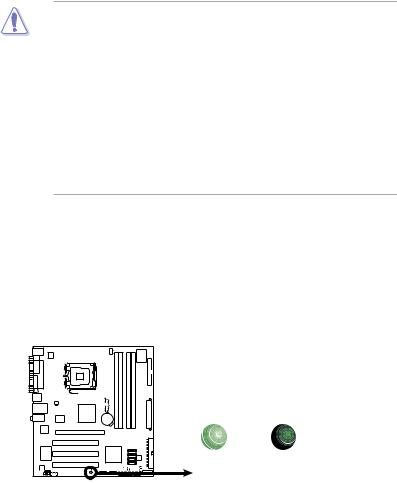
1.4Before you proceed
Take note of the following precautions before you install motherboard components or change any motherboard settings.
•Unplug the power cord from the wall socket before touching any component.
•Use a grounded wrist strap or touch a safely grounded object or to a metal object, such as the power supply case, before handling components to avoid damaging them due to static electricity
•Hold components by the edges to avoid touching the ICs on them.
•Whenever you uninstall any component, place it on a grounded antistatic pad or in the bag that came with the component.
•Before you install or remove any component, ensure that the ATX power supply is switched off or the power cord is detached from the power supply. Failure to do so may cause severe damage to the motherboard, peripherals, and/or components.
Onboard LED
The motherboard comes with a standby power LED that lights up to indicate that the system is ON, in sleep mode, or in soft-off mode. This is a reminder that you should shut down the system and unplug the power cable before removing or plugging in any motherboard component. The illustration below shows the location of the onboard LED.
P5GC-VM |
|
|
|
SB_PWR |
|
|
ON |
OFF |
|
Standby |
Powered |
P5GC-VM Onboard LED |
Power |
Off |
|
|
|
1- |
Chapter 1: Product introduction |
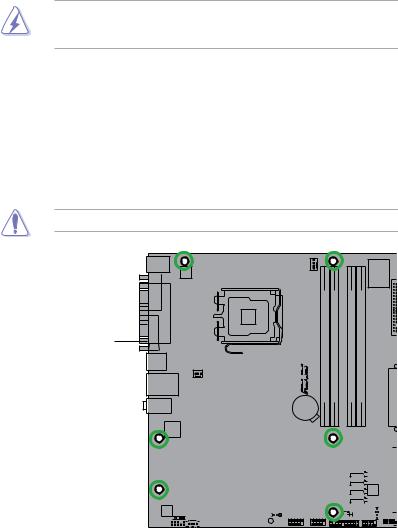
1.5Motherboard overview
Before you install the motherboard, study the configuration of your chassis to ensure that the motherboard fits into it.
Make sure to unplug the power cord before installing or removing the motherboard. Failure to do so can cause you physical injury and damage motherboard components.
1.5.1Placement direction
When installing the motherboard, make sure that you place it into the chassis in the correct orientation. The edge with external ports goes to the rear part of the chassis as indicated in the image below.
1.5.2Screw holes
Place six (6) screws into the holes indicated by circles to secure the motherboard to the chassis.
Do not overtighten the screws! Doing so can damage the motherboard.
Place this side towards the rear of the chassis
P5GC-VM
|
|
|
|
|
|
|
|
|
|
|
|
|
|
|
|
|
|
|
|
|
|
|
|
|
|
|
|
|
|
|
|
|
|
|
|
|
|
|
|
|
|
|
|
|
|
|
|
|
|
|
|
|
|
|
|
|
|
|
|
|
|
|
|
|
|
|
|
|
|
|
|
|
|
|
|
|
|
|
|
|
|
|
|
|
|
|
|
|
|
|
|
|
|
|
|
|
|
|
|
|
|
|
|
|
|
|
|
|
|
|
|
|
|
|
|
|
|
|
|
|
|
|
|
|
|
|
|
|
|
|
|
|
|
|
|
|
|
|
|
|
|
|
|
|
|
|
|
|
|
|
|
|
|
|
|
|
|
|
|
|
|
|
|
|
|
|
|
|
|
|
|
|
|
|
|
|
|
|
|
|
|
|
|
|
|
|
|
|
|
|
|
|
|
|
|
|
|
|
|
|
|
|
|
|
|
|
|
|
|
|
|
|
|
|
|
|
|
|
|
|
|
|
|
|
|
|
|
|
|
|
|
|
|
|
|
|
|
|
|
|
|
|
|
|
|
|
|
|
|
|
|
|
|
|
|
|
|
|
|
|
|
|
|
|
|
|
|
|
|
|
|
|
|
|
|
|
|
|
|
|
|
|
|
|
|
|
|
|
|
|
|
|
|
|
|
|
|
|
|
|
|
|
|
|
|
|
|
|
|
|
|
|
|
|
|
|
|
|
|
|
|
|
|
|
|
|
|
|
|
|
|
|
|
|
|
|
|
|
|
|
|
|
|
|
|
|
|
|
|
|
|
|
|
|
|
|
|
|
|
|
|
|
|
|
|
|
|
|
|
|
|
|
|
|
|
|
|
|
|
|
|
|
|
|
|
|
|
|
|
|
|
|
|
|
|
|
|
|
|
|
|
|
|
|
|
|
|
|
|
|
|
|
|
|
|
|
|
|
|
|
|
|
|
|
|
|
|
|
|
|
|
|
|
|
|
|
|
|
|
|
|
|
|
|
|
|
|
|
|
|
|
|
|
|
|
|
|
|
|
|
|
|
|
|
|
|
|
|
|
|
|
|
|
|
|
|
|
|
|
|
|
|
|
|
|
|
|
|
|
|
|
|
|
|
|
|
|
|
|
|
|
|
|
|
|
|
|
|
|
|
|
|
|
|
|
|
|
|
|
|
|
|
|
|
|
|
|
|
|
|
|
|
|
|
|
|
|
|
|
|
|
|
|
|
|
|
|
|
|
|
|
|
|
|
|
|
|
|
|
|
ASUS P5GC-VM |
1- |
|||||||||||||||||||||||||||||||

1.5.3Motherboard layout
PS/2KBMS
T: Mouse
B: Keyboard
ATX12V
COM1 |
PORT |
VGA |
PARALLEL |
USB34
CHA_FAN |
LAN1_USB12
|
|
|
|
|
|
AUDIO |
|
|
ICS 9L PRS412 |
|
|
|
|
|
|
|
|
|
|
Attansic
L1
ALC662
AAFP SPDIF_OUTCD
22.7cm (8.95in)
LGA775
Intel 82945GC
CPU_FAN |
|
|
|
|
|
|
|
|
|
|
|
Super I/O |
|
P5GC-VM |
bit,240-pin module) |
bit,240-pin module) |
bit,240-pin module) |
bit,240-pin module) |
FLOPPY |
|
R |
A1 (64 |
A2 (64 |
B1 (64 |
B2 (64 |
|
|
Lithium Cell |
DDR2 DIMM |
DDR2 DIMM |
DDR2 DIMM |
DDR2 DIMM |
EATXPWR |
24.4cm(9.6in) |
CR2032 3V |
|
|
|
|
|
|
CMOS Power |
|
|
|
|
|
|
PCIEX16
PCI1
PCI2
PCI3
PS2_USBPW |
USB56 |
SB_PWR |
|
SATA4 
Intel ICH7 SATA3  4Mb
4Mb
SATA2 BIOS
BIOS
USB78 |
TPM |
SATA1 |
F_PANELSPEAKER |
CHASSIS |
|||
|
|
CLRTC |
|
PRI_IDE
COM2
1- |
Chapter 1: Product introduction |
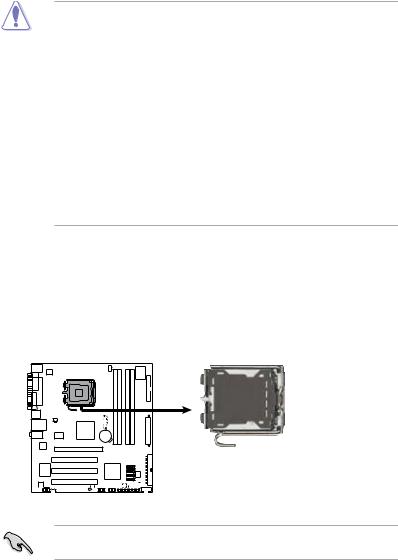
1.6Central Processing Unit (CPU)
The motherboard comes with a surface mount LGA775 socket designed for the Core™2 Duo/Pentium® D/Pentium® 4 and Celeron® D processors.
• Your boxed Intel® Core™2 Duo/Pentium® D/Pentium® 4 or Celeron® D
LGA775 processor package should come with installation instructions for the CPU, fan and heatsink assembly. If the instructions in this section do not match the CPU documentation, follow the latter.
•Upon purchase of the motherboard, make sure that the PnP cap is on the socket and the socket pins are not bent. Contact your retailer immediately if the PnP cap is missing, or if you see any damage to the PnP cap/socket pins/motherboard components.ASUS will shoulder the cost of repair only if the damage is shipment/transit-related.
•Keep the cap after installing the motherboard. ASUS will process Return
MerchandiseAuthorization (RMA) requests only if the motherboard comes with the cap on the LGA775 socket.
•The product warranty does not cover damage to the socket pins resulting from incorrect CPU installation/removal, or misplacement/loss/incorrect removal of the PnP cap.
1.6.1Installling the CPU
To install a CPU:
1.Locate the CPU socket on the motherboard.
P5GC-VM |
P5GC-VM CPU Socket 775
Before installing the CPU, make sure that the socket box is facing towards you and the load lever is on your left.
ASUS P5GC-VM |
1- |
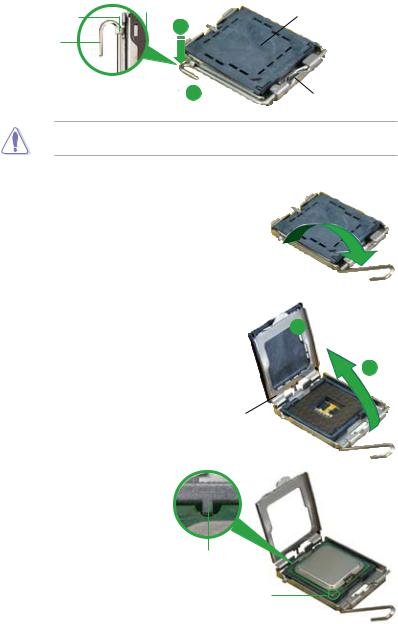
2.Press the load lever with your thumb (A) and move it to the left (B) until it is released from the retention tab.
Retention tab |
PnP Cap |
Load lever |
A |
|
B
This side of the cam box should face you.
To prevent damage to the socket pins, do not remove the PnP cap unless you are installing a CPU.
3.Lift the load lever in the direction of the arrow to a 135º angle.
4.Lift the load plate with your thumb and forefinger to a 100º angle (A), then push the PnP cap from the load plate window to remove (B).
B
A
Load plate
5.Position the CPU over the socket, making sure that the gold triangle is on the bottom left corner of the socket. The socket
alignment key should fit into the CPU notch.
Alignment key
Gold triangle mark
1-10 |
Chapter 1: Product introduction |

6. |
Close the load plate (A), then push |
A |
|
the load lever (B) until it snaps into |
|
|
the retention tab. |
|
B
The CPU fits in only one correct orientation. DO NOT force the CPU into the socket to prevent bending the connectors on the socket and damaging the CPU!
The motherboard supports Intel® LGA775 processors with the Enhanced Intel
SpeedStep® Technology (EIST), and Hyper Threading Technology.
ASUS P5GC-VM |
1-11 |
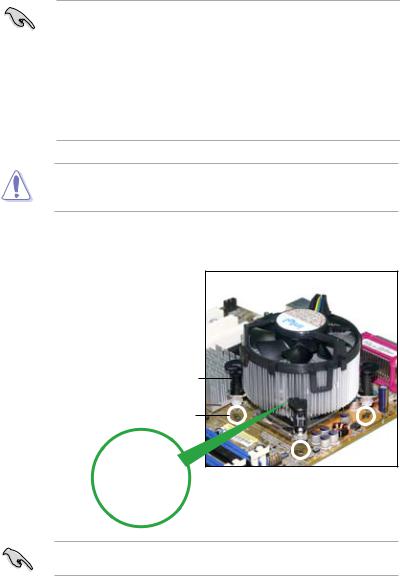
1.6.2Installling the CPU heatsink and fan
The Intel® Core™2 Duo/Pentium® D/Pentium® 4 and Celeron® D processors require a specially designed heatsink and fan assembly to ensure optimum thermal condition and performance.
•Install the motherboard to the chassis before you install the CPU fan and heatsink assembly
•When you buy a boxed Intel® Core™2 Duo/Pentium® D/Pentium® 4 or Celeron® D LGA775 processor, the package includes the CPU fan and heatsink assembly. If you buy a CPU separately, make sure that you use only Intel® certified multi directional heatsink and fan.
•Your I Intel® Core™2 Duo/Pentium® D/Pentium® 4 or Celeron® D LGA775 heatsink and fan assembly comes in a push-pin design and requires no tool to install.
If you purchased a separate CPU heatsink and fan assembly, make sure that a Thermal Interface Material is properly applied to the CPU heatsink or CPU before you install the heatsink and fan assembly.
To install the CPU heatsink and fan:
1.Place the heatsink on top of the installed CPU, making sure that the four fasteners match the holes on the motherboard.
Fastener
Motherboard
Make sure each fastener is oriented as shown, with the narrow groove directed outward.
1-12 |
Chapter 1: Product introduction |
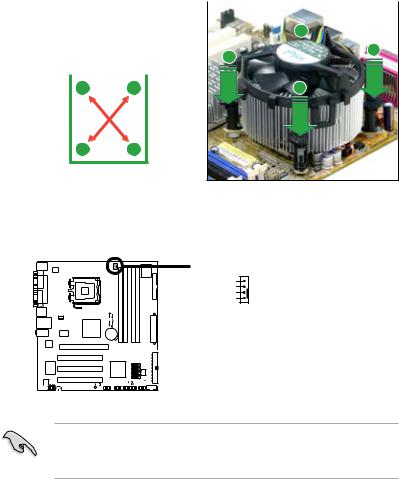
2. Push down two fasteners at a time |
|
|
|||
|
|
||||
in a diagonal sequence to secure |
|
B |
|||
the heatsink and fan assembly in |
|
||||
|
|
||||
place. |
|
|
A |
A |
|
|
|
|
|
|
|
|
|
|
|
|
|
|
A |
B |
|
B |
|
BA
3.When the fan and heatsink assembly is in place, connect the CPU fan cable to the connector on the motherboard labeled CPU_FAN.
P5GC-VM |
 CPU_FAN
CPU_FAN
CPU FAN PWM
CPU FAN IN
+12V
GND
P5GC-VM CPU Fan Connector
•Do not forget to connect the CPU fan connector! Hardware monitoring errors can occur if you fail to plug this connector.
•We recommend you to install the chassis fan for better thermal state.
ASUS P5GC-VM |
1-13 |

1.6.3Uninstalling the CPU heatsink and fan
To uninstall the CPU heatsink and fan:
1. |
Disconnect the CPU fan cable |
|
|
||
|
|
||||
|
from the connector on the |
|
|
||
|
motherboard. |
|
|
||
2. |
Rotate each fastener |
|
|
||
|
counterclockwise. |
|
|
||
3. |
Pull up two fasteners at a |
|
|
||
|
|
||||
|
|
||||
|
time in a diagonal sequence |
|
B |
||
|
to disengage the heatsink |
|
|||
|
|
|
|||
|
and fan assembly from the |
A |
A |
||
|
motherboard. |
|
|
||
|
|
|
|
|
B |
|
|
|
|
|
|
AB
BA
1-14 |
Chapter 1: Product introduction |
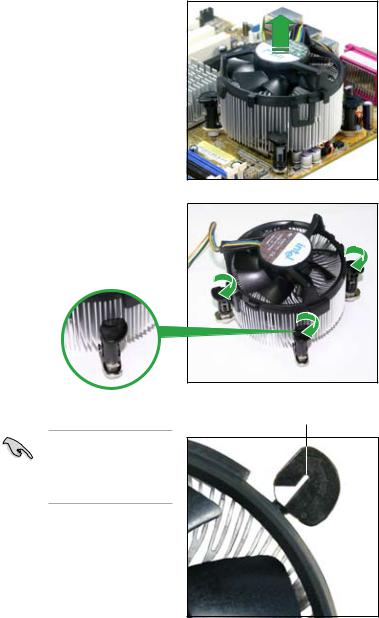
4.Remove the heatsink and fan assembly from the motherboard.
5.Rotate each fastener clockwise to reset the orientation.
The narrow end of the groove should point outward after resetting. (The photo shows the groove shaded for emphasis.)
Narrow end of the groove
ASUS P5GC-VM |
1-15 |
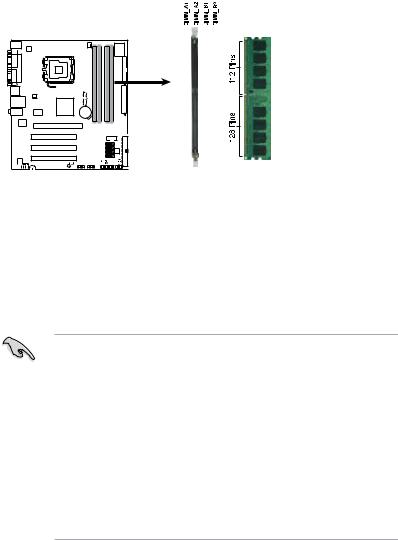
1.7System memory
1.7.1Overview
The motherboard comes with two Double Data Rate 2 (DDR2) Dual Inline Memory
Modules (DIMM) sockets.
ADDR2 module has the same physical dimensions as a DDR DIMM but has a 240-pin footprint compared to the 184-pin DDR DIMM. DDR2 DIMMs are notched differently to prevent installation on a DDR DIMM socket.
The figure illustrates the location of the DDR2 DIMM sockets:
P5GC-VM |
P5GC-VM 240-pin DDR2 DIMM Sockets
Channel |
Sockets |
ChannelA |
DIMM_A1 and DIMM_A2 |
Channel B |
DIMM_B1 and DIMM_B2 |
|
|
1.7.2Memory configurations
You may install 256 MB, 512 MB, 1 GB and 2 GB unbuffered non-ECC DDR2
DIMMs into the DIMM sockets.
•For dual-channel configuration, the total size of memory module(s) installed per channel must be the same (DIMM_A1 = DIMM_B1).
•When installing two or three DDR2 DIMM modules for single-channel configuration, this motherboard only supports single-sided memory modules.
•When installing four DDR2 DIMM modules, install the single-sided memory modules.
•When installing four single-sided DDR2 DIMM modules, the transfer rate reduces to 533 MHz.
•Always install DIMMs with the same CAS latency. For optimum compatibility, it is recommended that you obtain memory modules from the same vendor. Refer to the DDR2 Qualified Vendors List on next page for details.
1-16 |
Chapter 1: Product introduction |
1.7.3DDR2 Qualified Vendors List
The following table lists the memory modules that have been tested and qualified for use with this motherboard. Visit the ASUS website (www.asus.com) for the latest DDR2 DIMM modules for this motherboard.
DDR2 533 Qualified Vendors List
|
|
|
|
|
|
DIMM support |
||
Size |
Vendor |
Model |
Brand |
Side(s) |
Component |
A |
B |
C |
256MB |
Kingston |
KVR533D2N4/256 |
Elpida |
SS |
E5116AB-5C-E |
• |
• |
• |
256MB |
Kingston |
KVR533D2N4/256 |
Elpida |
SS |
E5116AF-5C-E |
• |
• |
• |
512MB |
Kingston |
KVR533D2N4/512 |
Infineon |
SS |
HYB18T512800AF3733336550 |
• |
• |
• |
1G |
Kingston |
KVR533D2N4/1G |
Kingston |
DS |
D6408TE7BL-37 |
• |
• |
|
1G |
Kingston |
KVR533D2N4/1G |
Kingston |
DS |
D6408TLRAGL37U |
• |
• |
|
256MB |
Samsung |
M378T3253FG0-CD5 |
Samsung |
SS |
K4T56083QF-GCD5 |
• |
• |
• |
512MB |
Samsung |
M378T6553BG0-CD5 |
Samsung |
SS |
K4T51083QB-GCD5 |
• |
• |
• |
512MB |
Qimonda |
HYS64T64000GU-3.7-A |
Qimonda |
SS |
HYB18T512800AC37SSS11511 |
• |
• |
• |
512MB |
Qimonda |
HYS64T64000HU-3.7-A |
Qimonda |
SS |
HYB18T512800AF37FSS29334 |
• |
• |
• |
256MB |
HY |
HYMP532U64CP6-C4AB |
Hynix |
SS |
HY5PS121621CFP-C4 |
• |
• |
• |
1G |
HY |
HYMP512U64CP8-C4AB |
Hynix |
DS |
HY5PS12821CFP-C4 |
• |
• |
|
512MB |
Micron |
MT 16HTF6464AG-53EB2 |
Micron |
DS |
D9BOM |
• |
• |
|
512MB |
Corsair |
VS512MB533D2 |
Corsair |
DS |
MI110052532M8CEC |
• |
• |
|
1G |
Corsair |
VS1GB533D2 |
Corsair |
DS |
64M8CFEGQIB0900718 |
• |
• |
|
512MB |
Elpida |
EBE51UD8ABFA-5C-E |
Elpida |
SS |
E5108AB-5C-E |
• |
• |
• |
512MB |
Kingmax |
KLBC28F-A8KB4 |
Kingmax |
SS |
KKEA88B4IAK-37 |
• |
• |
• |
256MB |
Kingmax |
KLBB68F-36EP4 |
Elpida |
SS |
E5116AB-5C-E |
• |
• |
• |
512MB |
Kingmax |
KLBC28F-A8EB4 |
Elpida |
SS |
E5108AE-5C-E |
• |
• |
• |
512MB |
ADATA |
M2OAD2G3H3166I1B52 |
ADATA |
SS |
AD29608A8A-37DG20719 |
• |
• |
• |
256MB |
AENEON |
AET560UD00-370A98Z |
AENEON |
SS |
AET94F370AWVV34635G0520 |
• |
• |
• |
512MB |
AENEON |
AET660UD00-370A98Z |
AENEON |
SS |
AET93F370A3VV36328G 0522 |
• |
• |
• |
512MB |
AENEON |
AET660UD00-370B97X |
AENEON |
SS |
AET93R370B 0640 |
• |
• |
• |
1G |
AENEON |
AET760UD00-370A98S |
AENEON |
DS |
AET92F370A0606 |
• |
• |
|
1G |
AENEON |
AET760UD00-370B97X |
AENEON |
DS |
AET93R370B 0640 |
• |
• |
|
1G |
AENEON |
AET760UD00-370B97S |
AENEON |
DS |
AET92R370B 0644 |
• |
• |
|
2G |
AENEON |
AET860UD00-370A08X |
AENEON |
DS |
AET03F370AFVV26176G 0542 |
• |
• |
|
512MB |
REMAXEL |
RML1040EG38D6F-533 |
Elpida |
SS |
E5108AG-5C-E |
• |
• |
• |
256MB |
TAKEMS |
TMS25B264B161-534KQ |
takeMS |
SS |
MS18T51216-3.70711 |
• |
• |
• |
512MB |
TAKEMS |
TMS51B264C081-534QI |
takeMS |
SS |
MS18T51280-3.7 |
• |
• |
• |
512MB |
TAKEMS |
TMS51B264C081-534AP |
takeMS |
SS |
MS18T51280-3.7P0704D |
• |
• |
• |
512MB |
TAKEMS |
TMS51B264C081-534AE |
takeMS |
SS |
MS18T51280-3.7EA07100 |
• |
• |
• |
1G |
TAKEMS |
TMS1GB264C081-534AE |
takeMS |
DS |
MS18T51280-3.7EA0651D |
• |
• |
|
1G |
TAKEMS |
TMS1GB264C081-534QI |
takeMS |
DS |
MS18T51280-3.7 |
• |
• |
|
1G |
TAKEMS |
TMS1GB264C081-534AP |
takeMS |
DS |
MS18T51280-3.7P0645D |
• |
• |
|
512MB |
VERITECH |
GTP512HLTM46DG |
VERITECH SS |
VTD264M8PC6G01A164129621 |
• |
• |
• |
|
1G |
VERITECH |
GTP01GHLTM56DG |
VERITECH DS |
VTD264M8PC6G01A164129621 |
• |
• |
|
|
ASUS P5GC-VM |
1-17 |
